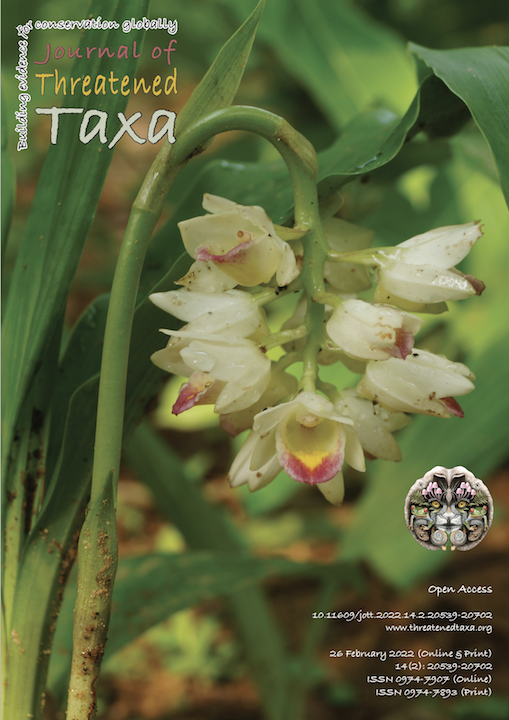First Indian DNA barcode record for the moth species Pygospila tyres (Cramer, 1780) (Lepidoptera: Crambidae: Spilomelinae) distributed in Asia and Australia
Main Article Content
Abstract
The species Pygospila tyres was described from the Coromandel region of India about 240 years ago, accommodated in the family Crambidae having immense importance. The species is morphologically cryptic and is known to have 10 extant species under the genus. Earlier mt DNA Barcodes for the species were available from Pakistan, Korea, and Australia, here we report the first barcode of the species from the country of its type locality. Morphological details for the collections with the male and female genitalia are provided for the taxonomic identification. Identities of the mt COI DNA sequences for the genus in the GenBank are discussed.
Article Details

This work is licensed under a Creative Commons Attribution 4.0 International License.
Authors own the copyright to the articles published in JoTT. This is indicated explicitly in each publication. The authors grant permission to the publisher Wildlife Information Liaison Development (WILD) Society to publish the article in the Journal of Threatened Taxa. The authors recognize WILD as the original publisher, and to sell hard copies of the Journal and article to any buyer. JoTT is registered under the Creative Commons Attribution 4.0 International License (CC BY), which allows authors to retain copyright ownership. Under this license the authors allow anyone to download, cite, use the data, modify, reprint, copy and distribute provided the authors and source of publication are credited through appropriate citations (e.g., Son et al. (2016). Bats (Mammalia: Chiroptera) of the southeastern Truong Son Mountains, Quang Ngai Province, Vietnam. Journal of Threatened Taxa 8(7): 8953–8969. https://doi.org/10.11609/jott.2785.8.7.8953-8969). Users of the data do not require specific permission from the authors or the publisher.
References
Ashfaq, M., S. Akhtar, M.A. Rafi, S. Mansoor & P.D. Hebert (2017). Mapping global biodiversity connections with DNA barcodes: Lepidoptera of Pakistan. PLoS One 12(3): e0174749. https://doi.org/10.1371/journal.pone.0174749
Caradja, V.F.A. (1916). Beitragzur Kenntnis der geographischen Verbreitung der Pyraliden und Tortriciden deseuropäischen Faunengebietes, nebst Beschreibungneuer Formen. Deutsche Entomologische Zeitschrift “Iris”, herausgegeben vom Entomologibchen Verein Iris zu Dresden. Jahrgang, 152 pp.
Caradja, A. & E. Meyrick (1937). Materialienzueiner Mikrolepidopterenfauna des Yülingshanmassivs (Provinz Yünnan) Deutsche entomologische Zeitschrift Iris.
Folmer, O., W.R. Hoeh, M.B. Black & R.C. Vrijenhoek (1994). Conserved primers for PCR amplification of mitochondrial DNA from different invertebrate phyla. Molecular Marine Biology and Biotechnology 3(5): 294–299.
Hains, W.P. & D. Rubinoff (2012). Molecular phylogenetics of the moth genus Omiodes Guenée (Crambidae: Spilomelinae), and the origins of the Hawaiian lineage. Molecular Phylogenetics and Evolution 65(1): 305–316.
Hampson, G.F. (1896). The fauna of British India including Ceylon and Burma, Moths - Volume 4. Taylor and Francis, London, 595 pp.
Hebert, P.D., A. Cywinska, S.L. Ball & J.R. Dewaard (2003). Biological identifications through DNA barcodes. Proceedings of the Royal Society of London. Series B: Biological Sciences 270(1512): 313–321.
Hebert, P.D., J.R. DeWaard, E.V. Zakharov, S.W. Prosser, J.E. Sones, J.T. McKeown, B. Mantle & L.J. Salle (2013). A DNA ‘Barcode Blitz’: Rapid digitization and sequencing of a natural history collection. PloS One 8(7): e68535.
ICAR-NBAIR (2020). Pygospila tyres. https://www.nbair.res.in/Databases/insectpests/Pygospila-tyres.php. Electronic version accessed 12 October 2020.
Jotwani, M.G. & W.R. Young (2007). Recent developments in chemical control of insect pests of sorghum, pp. 377–398. In: Rao, N.G.P. & L.R. Hou-se (eds.). Sorghum in Seventies. Oxford and IBH Publishing, New Delhi, India.
Kalawate, A.S., S. Pawara, A. Shabnam & K.P. Dinesh (2020a). DNA Barcode revealed the occurrence of Paleartic Olepa schleini Witt, Müller, Kravchenko, Miller, Hausmann & Speidel, 2005 (Lepidoptera, Erebidae, Arctiinae) from the peninsular India with the report of morphological variations and a new sub species. Journal of Threatened Taxa 12(9): 16143–16152. https://doi.org/10.11609/jott.5596.12.9.16143-16
Kalawate, A.S., K.P. Dinesh & A. Shabnam (2020b). DNA barcoding unravels three new species and a subspecies of Olepa Watson, 1980 (Lepidoptera, Erebidae, Arctiinae) from India, with morphotypes. Journal of Insect Biodiversity 19(2): 44–60. https://doi.org/10.12976/jib/2020.19.2.2
Kenrick, G.H. (1907). A list of moths of the family Pyralidae collected by A. E. Pratt in British New Guinea in 1902-3, with descriptions of new species, pp. 68–87. In: Proceedings of the Zoological Society of London.
Kitching, R.L., L.A. Ashton, A.G. Orr & E.H. Odell (2020). The Pyraloidea of Eungella: A moth fauna in its elevational and distributional context. Proceedings of The Royal Society of Queensland, 65–79pp.
Kumar, R., V. Mittal, N. Kumar & V.V. Ramamurthy (2013). Taxonomic aid to major crambid vegetable pests from north India (Lepidoptera: Crambidae). Munis Entomology and Zoology Journal 8(2): 858–875.
Mally, R., J.E. Hayden, C. Neinhuis, B.H. Jordal & M. Nuss (2019). The phylogenetic systematics of Spilomelinae and Pyraustinae (Lepidoptera: Pyraloidea: Crambidae) inferred from DNA and morphology. Arthropod systematics and Phylogeny 77(1): 141–204.
Meyrick, E. (1937). Exotic microlepidoptera – 2nd Edition. Taylor and Francis, London, 32 pp.
Minet, J. (1981). Les Pyraloidea et leurs principales divisions systématiques (Lep. Ditrysia). Bulletin de la Société Entomologique de France, Paris, 86: 262–280.
Robinson, G.S. (1976). The preparation of slides of Lepidoptera genitalia with special reference to the Microlepidoptera. Entomologist’s Gazette 27: 127–132.
Silvestro, D. & I. Michalak (2012). raxmlGUI: a graphical front-end for RAxML. Organism Diversity and Evolution 12: 335–337. https://doi.org/10.1007/s13127-011-0056-0
Solis, M.A. (1997). Snout moths: Unraveling the taxonomic diversity of a speciose group in the Neotropics, pp. 231–242. In: Reaka-Kudla M.L., D. Wilson & E.O. Wilson (eds.). Biodiversity II: Understanding and Protecting our Biological Resources. Joseph Henry Press, Washington, D.C., 551 pp.
Solis, M.A. & K.V.N. Maes (2003). Preliminary phylogenetic analysis of the subfamilies of Crambidae (Pyraloidea Lepidoptera). Belgian Journal of Entomology 4: 53–95.
Solis, M.A. (2007). Phylogenetic studies and modern classification of the Pyraloidea (Lepioptera). Revista Colombiana de Entomología 33(1): 1–9.
Tamura, K., D. Peterson, N. Peterson, G. Stecher, M. Nei & S. Kumar (2011). MEGA5: Molecular Evolutionary Genetics Analysis Using Maximum Likelihood, Evolutionary Distance, and Maximum Parsimony Methods. Molecular Biology and Evolution 28(10): 2731–2739. https://doi.org/10.1093/molbev/msr121
Turner, J.A. (1908). New Australian Lepidoptera of the families Noctuidae and Pyralidae. Transactions of the Royal Society of South Australia 32(1908): 94–95.

